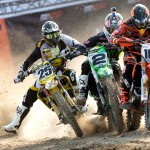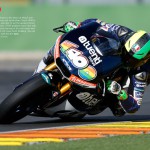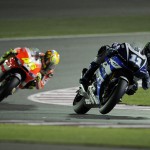One of the main pieces of news to emerge from the world of MXGP over the last week was not only the disappointment of Husqvarna losing two of their principal stars in either category for the coming races or the sight of Romain Febvre enjoying his fresh star status by rubbing shoulders with Valentino Rossi at Assen but the elaborate presentation by the Dutch on the eve of their MotoGP fixture about their debut MXGP bow in August.
The depth of ambition for the MXGP of the Netherlands at the famous site was made clear and Assen have been deadly serious about driving more racing activities and meetings to their renowned circuit for the last couple of years. With Youthstream President Giuseppe Luongo acknowledging in the wake of the weather-battering and swampy experience at Maggiora – and with the bursting size of Grand Prix now due to a copious European Championship support card – MXGP venues really need to offer the right infrastructure to continue growth then it is not a surprise that the FIM World Championship is again welcoming purpose-built tracks in permanent motorsport facilities as part of the schedule.
Importing soil and crafting a temporary motocross track over road racing asphalt has met with derision, grudging acceptance and never-ending optimism in the last twenty years. For every failed experiment like Lausitzring for the 2013 German Grand Prix or Nakhonchaisri in Thailand in March there have been passable attempts like Zolder (Flanders GPs in 2004, ’05 and ’06 with the ’03 Nations as well), Donington Park (2008 British GP and Nations), Mallory Park (2009 and 2010 British GPs) and Franciacorta (2009 Nations). MXGP is having another push towards this type of event. In 2015 there is two with Losail in Qatar opening the series for the third year in a row and of course the Assen sand set to be moved at the end of August. In 2016 that could expand to three with Sepang set to stage the first Grand Prix of Malaysia.
What are the drawbacks? What have been the failings of taking MXGP into these ‘arenas’? While the capability to use all the installed facilities, parking, access and recognised names and locations of the circuits is a clear advantage, some of the organisers have failed to understand the principal appeal of the sport for the average motorsport fan: proximity.
Admiring the speed of the riders across rough terrain, marvelling at aerial distance and ability and almost reeling from engine heat as well as being able to wave flags and bellow at favourite racers trackside has been one of the long-standing hallmarks of following the sport. That closeness also creates atmosphere, which in turn increases tension and conversely enjoyment of a race. Lausitzring was a modern and ‘easy’ circuit but the fans were too far, too few and the event had the ambience of a practice day. Losail suffers in the same way but is an anomaly because the whole set-up would probably work very well in another geographical area. The event vibe relies on the lights rather than packed viewing enclosures.
Fans can sit comfortably in a stadium seat and wonder at the speed of a MotoGP bike passing for twenty laps but that dynamic is lost in motocross where every metre further from the side of the track somehow reduces the sport’s power to magnetise and nullifies the empathy that many of the spectators – often riders themselves – want to savour from watching their heroes attack terrain ten times faster than they would. For this reason spectators also like to move around.
I hope Assen is not falling into the same trap. They are offering stadium seating and have designed the trajectory of the track around the same chicane where Rossi and Marquez memorably decided the recent TT Assen but seem to be aware of ‘the gap’ and have brought the course as close to the structure as possible. I do doubt any new fans’ receptivity to remaining seated for the entire day. The premise works in supercross or speedway where the programme rattles along at a rapid pace and with distractions like lights, intros, girls etc. Four motos plus all the support races is a tall ‘ask’ (but no doubt more comfortable if raining).
For the racing surface itself then track criticism can be valid particularly as freshly laid soil often takes time to bed-in and can provide a weird feeling but at the same time riders are quick to slate age-old circuits around Europe for their lack of lines, prep and wear. In theory with a clean design slate the layout should be modern and accommodating.
‘MXGP over the asphalt’ should work and I feel there is definitely a place for it in the calendar alongside hard-pack like St Jean D’Angely, hills like at Loket and sandy waves of Lierop to add to the World Championship’s depth of challenge and interesting diversity. It is also a clear way to try and drive motocross out from remote fields and obscurity towards more mainstream attention. Youthstream are promoters. Their job is to spread the word as it would be for any other company with the rights and the fact that the manufacturers are onboard with some of the more radical modern ideas (one round of the 2016 calendar could even see Grand Prix inside a stadium in Germany) indicates that everybody involved and investing in MXGP would like to try for growth.
However there is the nagging thought (along with some of the spiritual wrench from the roots of the sport) that road race tracks is a short-term answer with debatable profitability. It might be the only way to entice a new audience that would be repelled from having to sit on banks of soggy mud as was the case in Italy and might have been a bigger mess if Villars sous ecot had been wet for the French round in May.
Somehow new fans have to be drawn into MXGP, welcomed into the paddock and stuck mere metres from some of the coolest jumps and gnarliest technical sections but in the most comfortable and easy way possible. The sport is stirring like the beginnings of a tornado at the moment with passions over injury rates running high, scepticism over the 450cc capacity, suitable race circuits and an over-intense race programme all leading to meetings around tables.
Photo by www.mxgp-assen.com








